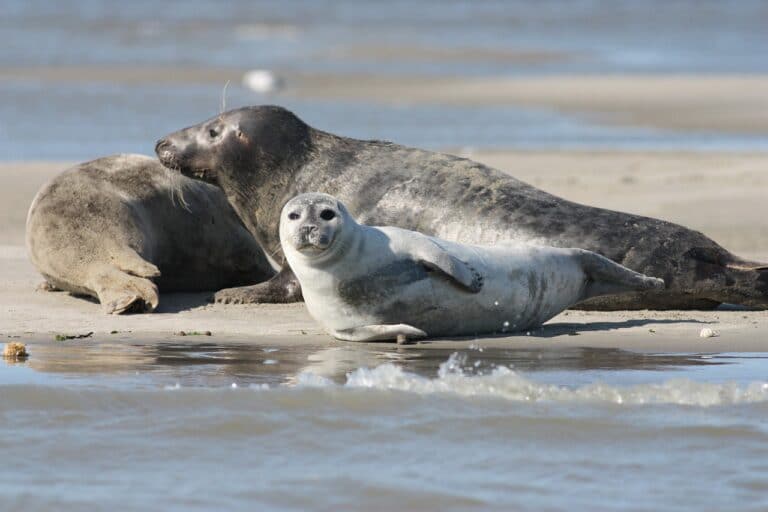Grey Seal – (Halichoerus grypus)
The grey seal, or gray seal in American English, is a remarkable marine creature commonly found in the coastal waters of the northern hemisphere. Unlike their eared seal counterparts, grey seals are true seals, known for their captivating and inquisitive nature towards humans. While it’s crucial to emphasize responsible wildlife interactions, there are numerous heartwarming instances of these incredible beings approaching and playfully engaging with scuba divers, leaving unforgettable memories etched in the minds of those fortunate enough to encounter them.
Grey seals, as their name suggests, primarily sport a sleek grey coat. They boast fewer spots compared to their close relatives, the harbor seals, often coexisting in the same waters. Size-wise, they are formidable, with the largest males, aptly known as ‘bulls,’ reaching lengths of approximately 3 meters and weighing nearly 400 kilograms. One of the most distinguishing features between the two species lies in the side profile of their heads, often the only part visible above the water’s surface. They possess a longer, straighter nose, resembling that of a dog, with nostrils set further apart.
These remarkable creatures have relatively long lifespans, spanning between 25 and 35 years. Remarkably, females start breeding as early as four years old and typically outlive their male counterparts by an average of ten years.
Grey seals predominantly feast on fish, showcasing their prowess as skilled hunters. They also incorporate squid, mollusks, crabs, octopuses, and, occasionally, seabirds into their diet. To maximize efficiency, grey seals often engage in group hunting. However, nature’s complex web sometimes takes a darker turn, with documented instances of cannibalism within the species, and predation on common seals and harbor porpoises.
Breeding season for grey seals is a demanding period. During this time, they endure fasting, which includes the critical three-week period when females nurse their pups. The females give birth to a single pup after an eleven-month gestation period. These pups are incredibly vocal, often emitting sounds reminiscent of human babies crying. These distinct vocalizations serve as a means for mothers to locate their young within bustling colonies, where thousands of seals gather during breeding season.
Despite their resilience, grey seals face an array of threats, both natural and human-induced. Among the challenges they confront are diseases, hunting, entanglement in marine debris, pollution, and unintentional capture in fishing nets as bycatch. Furthermore, grey seals occupy a slot in the marine food chain, rendering them vulnerable to predation by apex predators like killer whales.
In Iceland, these charismatic grey seals contribute to the rich tapestry of marine life that makes the country’s coastal waters a true treasure trove of biodiversity. Their enigmatic behavior and distinctive appearance continue to captivate and inspire those who venture into the aquatic realms of Iceland.
As we marvel at these magnificent creatures, it is our collective responsibility to protect their habitats, respect their boundaries, and ensure that the grey seals, along with other marine species, thrive in the wild for generations to come.
Iceland’s commitment to conservation efforts is reflected in its dedication to safeguarding these precious creatures. Protected areas have been established, and fishing regulations have been implemented to minimize the impact of human activities on grey seal populations. Monitoring programs ensure that we remain vigilant in the face of changing environmental conditions.
As we witness the interplay of nature’s forces, we come to appreciate the intricate web of life that encompasses the grey seal’s world. From the rhythmic waves that lap at Iceland’s shores to the stark beauty of its rocky coastlines, the habitat of grey seals is an integral part of the country’s natural heritage.
The grey seal’s ability to coexist harmoniously with humans has captivated our imagination for centuries. Tales of these friendly and inquisitive beings have been passed down through generations, weaving their presence into the fabric of Icelandic folklore. While we must approach them with respect and restraint, the encounters shared between these animals and scuba divers serve as a testament to the bond that exists between humans and the natural world.
In closing, the grey seal’s story is but one chapter in the epic saga of Iceland’s marine life. It is a testament to the resilience and adaptability of nature’s creatures in the face of adversity.

